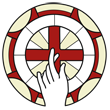La cappella, di patronato della famiglia Natta, ospita una monumentale alzata d’altare in legno intagliato, dipinto, dorato, realizzata da Giuseppe Badarello nel 1694. La pala centrale raffigura San Giovanni Battista che battezza le folle, olio su tela di anonimo pittore lombardo realizzato nel 1694. Attribuito allo stesso pittore, nella parte sommitale dell’altare, l’altra tela ovale con San Giovannino e Gesù Bambino. Sulla cornice inferiore della pala è presente l’iscrizione: «INTER NATOS MULIERUM NON SUREXIT MAIOR IOANNE BAPTISTA» («Tra i nati di donna nessuno fu più grande di Giovanni Battista»).
Sui quattro spicchi di parete ai lati dell’altare sono rappresentati altrettanti momenti della vita di san Giovanni Battista: da sinistra a destra, La decollazione di san Giovanni Battista, San Giovanni Battista nel deserto, Il battesimo di Gesù e La danza di Salomè. Questi affreschi sono opera di Salvatore Bianchi (1653-1727), realizzati tra il 1680 e il 1690. Nella parte superiore dei due affreschi centrali è rappresentato lo stemma della famiglia Natta.
The chapel, under the patronage of the Natta family, houses a monumental carved, painted,
and gilded wooden altarpiece created by Giuseppe Badarello in 1694. The central altarpiece
depicts Saint John the Baptist baptizing the crowds, an oil on canvas painted by an
anonymous Lombard painter in 1694. Made by the same painter, at the top of the altar, there
is another oval canvas depicting Saint John the Baptist as a child and the Infant Jesus. On
the lower frame of the altarpiece, there is an inscription that reads: "INTER NATOS
MULIERUM NON SUREXIT MAIOR IOANNE BAPTISTA" ("Among those born of women,
there has not risen anyone greater than John the Baptist").
On the four sections of the wall surrounding the altar, four different moments of Saint John
the Baptist's life are depicted: from left to right; The Beheading of Saint John the Baptist,
Saint John the Baptist in the desert, The Baptism of Jesus, and The Dance of Salome.
These frescoes were created by Salvatore Bianchi (1653-1727) between 1680 and 1690.
The upper parts of the two central frescoes feature the sigil of the Natta family.
